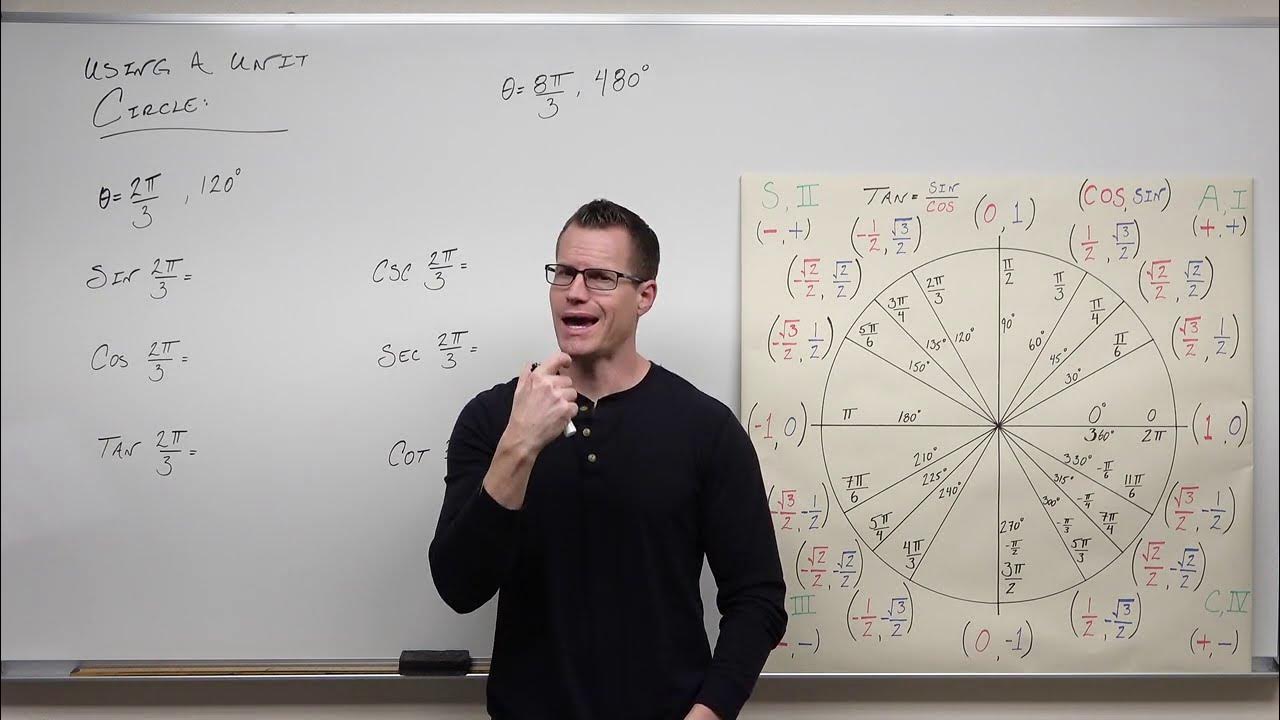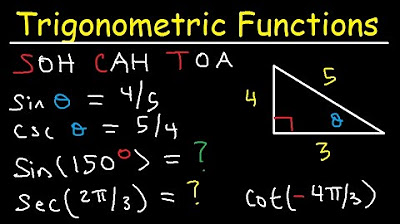Finding Exact Values of Trig Functions
TLDRIn this informative video, the presenter guides viewers through the process of evaluating trigonometric functions at various angles without relying on the unit circle. By utilizing reference angles, coterminal angles, and understanding of quadrants, the video demonstrates how to find exact values for sine, cosine, tangent, secant, and cotangent. The presenter emphasizes the importance of basic trigonometric identities and the concept of quadrants over memorizing the entire unit circle, offering a practical approach to trigonometry.
Takeaways
- 📐 The video focuses on evaluating trigonometric functions at different angles using reference angles and coterminal angles.
- 🎯 Memorizing only a few key angles from the unit circle (like 0, π/6, and π/4) is sufficient for finding trig function values in any quadrant by understanding how quadrants work and how to find reference angles.
- 🖊️ For sine of 7π/6, the reference angle is π/6, and since it's in the third quadrant, the value is negative, resulting in -1/2.
- 📐 For cosine of 5π/3, the reference angle is π/3, and since it's in the fourth quadrant, the value is positive, resulting in 1/2.
- 🔄 To simplify angles, adding or subtracting multiples of 2π can shift the angle to a more manageable value between 0 and 2π.
- 🤔 For tangent of 7π/6, basic trigonometric identities are used to express tangent in terms of sine and cosine, and the reference angle is π/6, leading to a positive value.
- 🚫 Memorizing the entire unit circle is not necessary; understanding the concepts of reference angles and quadrants is more beneficial.
- 🌟 Secant of π/2 is undefined because the value of X is zero, making the expression R/X, which equals 1/0.
- 🔄 For negative angles, adding 2π can help find the reference angle in a more familiar position.
- 📊 The video provides examples of finding exact values for sine, cosine, tangent, secant, and cotangent using reference angles and basic identities.
Q & A
What is the main topic of the video?
-The main topic of the video is evaluating trigonometric functions and finding their exact values at different angles using reference angles, coterminal angles, and knowledge of quadrants.
Why does the video creator suggest not memorizing the entire unit circle?
-The video creator suggests not memorizing the entire unit circle because knowing a few key angles, how quadrants work, and how to find reference angles allows one to find the values of any trigonometric function at any angle without relying on the unit circle.
How does the video demonstrate finding the sine of 7π/6?
-The video demonstrates finding the sine of 7π/6 by identifying that it is in the third quadrant, finding the reference angle (π/6), knowing that sine of π/6 is 1/2, and then applying the sign rule for the third quadrant to determine that the value is negative, resulting in -1/2.
What is the process for finding the cosine of 5π/3?
-To find the cosine of 5π/3, the video first identifies that it is not in the first quadrant. It then draws a rough sketch of the angle and finds the reference angle (π/3). Knowing that cosine of π/3 is 1/2, the video applies the sign rule for the fourth quadrant, where cosine is positive, to conclude the value is 1/2.
How does the video handle negative angles in trigonometric function evaluation?
-The video handles negative angles by using the concept of coterminal angles. It adds or subtracts multiples of 2π to the negative angle to convert it into a positive angle that is easier to work with, and then uses the sign rules for the appropriate quadrant to determine the final sign of the value.
What is the significance of reference angles in trigonometric function evaluation?
-Reference angles are significant in trigonometric function evaluation because they allow one to find the values of trigonometric functions for any angle by reducing the angle to a simpler form that lies within the first quadrant, where the function values are more easily known or memorized.
How does the video approach finding the tangent of 7π/6?
-The video approaches finding the tangent of 7π/6 by first identifying the reference angle (π/6). It then uses the basic identity for tangent, which is sine over cosine, and finds the values for sine and cosine of the reference angle. After calculating the ratio, it checks the sign based on the quadrant (positive in the third quadrant) to determine the final value.
What is the method for finding the secant of π/2?
-The method for finding the secant of π/2 involves recognizing that π/2 is a quadrantal angle. The video draws a point at π/2 on the y-axis and uses the definition of secant (R over X). Since X is zero at this point, the secant value is undefined because division by zero is not possible.
How does the video explain the use of basic trigonometric identities to find values of other trigonometric functions?
-The video explains that by knowing the basic trigonometric identities, such as cosecant being the reciprocal of sine and secant being the reciprocal of cosine, one can find the values of these functions using the known values of sine and cosine. This approach reduces the need to memorize a large number of values and instead relies on understanding the relationships between the functions.
What is the process for finding the cotangent of 2π/3?
-To find the cotangent of 2π/3, the video first subtracts 2π to get an equivalent positive angle (2π/3 - 2π = 2π/3 - 6π/3 = -4π/3). It then identifies the reference angle (π/3) and evaluates the cotangent using the definition (cosine over sine). After calculating the ratio, it checks the sign based on the quadrant (negative in the second quadrant) to determine the final value, which is negative.
What are the key takeaways from the video for evaluating trigonometric functions?
-The key takeaways from the video are the importance of understanding reference angles, coterminal angles, and quadrant rules for sign determination. It also emphasizes the use of basic trigonometric identities to find values of functions without extensive memorization of the unit circle. Additionally, the video provides strategies for handling negative angles and quadrantal angles.
Outlines
📚 Evaluating Trigonometric Functions Using Reference Angles
The paragraph introduces the concept of evaluating trigonometric functions without relying on the unit circle. It explains the use of reference angles and coterminal angles, as well as the importance of understanding quadrants to find the values of trigonometric functions at various angles. The speaker demonstrates how to find the sine of 7π/6 by identifying its reference angle (π/6) and determining its sign based on the quadrant (negative in the third quadrant). The process is then applied to cosine of 5π/3, emphasizing the importance of recognizing the quadrant to determine the sign of the function.
📐 Working with Trigonometric Functions in Different Quadrants
This section delves into the specifics of finding trigonometric function values in different quadrants. The speaker explains how to handle negative angles by using the unit circle or simply drawing the angle. The example of cosine of -2π/3 is used to illustrate this process. The paragraph also tackles the challenge of finding tangent of 7π/6, which is not directly on the unit circle. By using basic trigonometric identities, the speaker shows how to express tangent in terms of sine and cosine and then evaluate it based on the reference angle and the quadrant's characteristics.
🔢 Finding Exact Values for Trigonometric Functions
The final paragraph focuses on finding exact values for various trigonometric functions, emphasizing the ease of finding values for quadrantal angles. The speaker uses the example of secant of π/2 to demonstrate this, highlighting that the value is undefined when the angle is on the y-axis. The paragraph also covers the use of reciprocal identities to find values for functions like cosecant and secant without memorizing extensive tables. The speaker provides examples for cosecant of -π/6 and secant of 5π/3, showing how to determine the sign of the function based on the quadrant. The paragraph concludes with a brief overview of the methods discussed and encourages viewers to practice these techniques.
Mindmap
Keywords
💡Trigonometric Functions
💡Reference Angles
💡Quadrants
💡Unit Circle
💡Coterminal Angles
💡Trigonometric Identities
💡Secant
💡Cosecant
💡Cotangent
💡Exact Values
💡Brain Muscles
Highlights
The video focuses on evaluating trigonometric functions and finding exact values at different angles without relying on the unit circle.
Reference angles and coterminal angles are used to find the values of trig functions at any angle.
Memorizing only three angles for sine and cosine from the first quadrant of the unit circle is sufficient for solving problems.
The method of finding reference angles is demonstrated using sine of 7π/6 as an example.
The sign of the trigonometric function is determined by the quadrant in which the angle lies.
Cosine of 5π/3 is calculated by finding its reference angle and using the known value from the unit circle.
The video explains how to find the exact value of sine of 15π/4 by subtracting or adding 2π to the angle.
The reference angle for 7π/4 is found to be π/4, and the value of sine is determined to be negative root 2 over 2.
The process of finding the tangent of 7π/6 involves basic trigonometric identities and finding the reference angle.
Secant of π/2 is demonstrated as a quadrantal angle, resulting in an undefined value since the X value is zero.
Cosecant of negative π/6 is calculated by finding the reference angle and using the reciprocal of sine.
Secant of 5π/3 is evaluated by finding the reference angle and using the reciprocal of cosine.
Cotangent of 2π/3 is calculated by finding the reference angle and using the reciprocal relationship between cotangent and tangent.
The video emphasizes the importance of understanding basic trigonometric identities and how quadrants affect the signs of trigonometric functions.
The method for finding exact values of trigonometric functions is shown to be effective without memorizing the entire unit circle.
The video provides a practical approach to trigonometry that can be applied to a variety of problems.
The presenter encourages viewers to continue practicing and flexing their brain muscles for future videos.
Transcripts
Browse More Related Video

The Unit Circle, Basic Introduction, Trigonometry

How to Use the Unit Circle in Trigonometry (Precalculus - Trigonometry 7)

Reciprocal Identities - Evaluating Secant and Cosecant Functions

Trigonometric Functions of Any Angle - Unit Circle, Radians, Degrees, Coterminal & Reference Angles

Even and Odd Trigonometric Functions & Identities - Evaluating Sine, Cosine, & Tangent

Trigonometry Final Exam Review
5.0 / 5 (0 votes)
Thanks for rating: